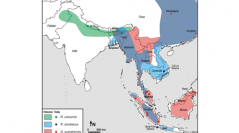

 Comptes Rendus Palevol
11 (2-3) - Pages 159-168
Comptes Rendus Palevol
11 (2-3) - Pages 159-168Rhinocerotids were abundant and diverse in southern Asia during the Pleistocene and the Holocene epochs, as shown by palaeontological and archaeological discoveries published throughout the last century, whereas the only living rhinoceros in the Indochinese Peninsula is Rhinoceros sondaicus (Cat Loc Reserve, Vietnam). The Pleistocene-Holocene Indochinese rhinocerotid record consists of the extinct species Dicerorhinus gwebinensis (Early Pleistocene, Myanmar) and representatives of the Recent Asian Species Rhinoceros unicornis (Middle-Late Pleistocene), R. sondaicus (Middle Pleistocene-Recent), and Dicerorhinus sumatrensis (Middle Pleistocene-Holocene). This fossil record is synthesized, mapped for Early/Middle/Late Pleistocene and Holocene/Recent times, and then compared with coeval rhinocerotid assemblages from the adjacent areas (South China), subregions (Indian, Sundaic, Philippine, and Wallacean), and region (Palearctic), from a biochronological and biogeographical perspective.
Rhinocerotidae, Rhinocerotina, Systematics, Biochronology, Biogeography, Indo-Malayan region, Sundaic subregion